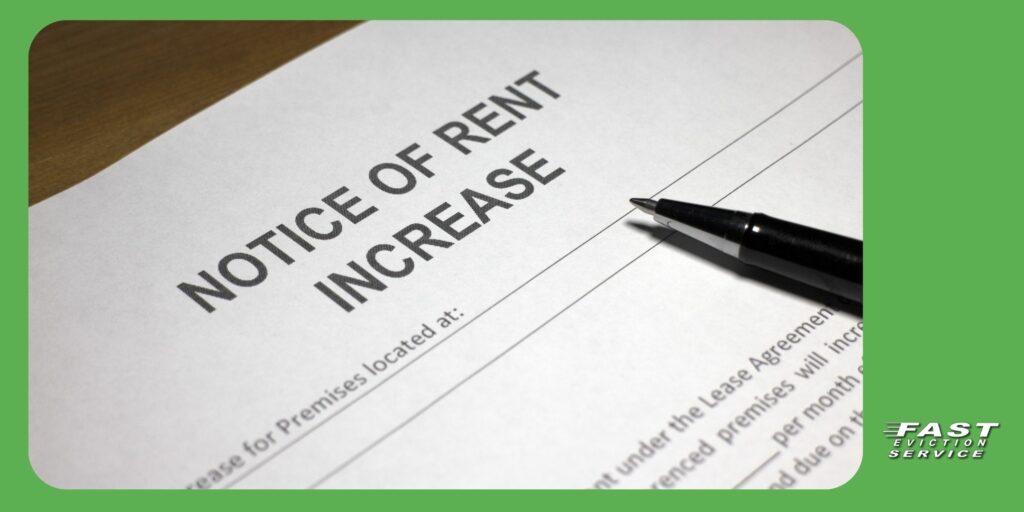You are represented at all times by one of our California Eviction Attorneys | 1-800-686-8686 | intake@fastevict.com | Se habla español
California Tenant Protection Act: The Ultimate Guide on AB 1482
For landlords across California, the California Tenant Protection Act (AB 1482) remains one of the most important housing laws to understand. Since taking effect in 2020, this legislation has reshaped how property owners manage rent increases and tenant evictions. It establishes strict rules on how much rent can rise annually and limits the reasons a landlord can terminate a tenancy.
Whether you own a single-family home, a duplex, or a multi-unit apartment building, understanding how AB 1482 applies to your property is critical. Staying compliant not only helps you avoid legal disputes but also ensures you operate your rental business within California’s evolving housing landscape.
Key Takeaways
- AB 1482 limits annual rent increases to 5% plus the local CPI or 10%, whichever is lower.
- “Just-cause” eviction requirements apply after 12 months of tenancy.
- Certain properties are exempt, including new construction (less than 15 years old) and some single-family homes.
- Landlords must provide relocation assistance or rent waivers for “no-fault” evictions.
- Proper notice and documentation are essential for compliance.

Table of Contents
- What is the California Tenant Protection Act (AB 1482)?
- Rent Increase Limits Under AB 1482
- Just-Cause Eviction Requirements for Landlords
- Exemptions and Special Cases Landlords Should Know
- Local Ordinances and Regional Differences
- Compliance Tips for California Landlords
- Common Questions Landlords Ask About AB 1482
- Conclusion
What is the California Tenant Protection Act (AB 1482)?
The California Tenant Protection Act, also known as AB 1482, was enacted in 2019 and took effect on January 1, 2020. Its purpose is to curb excessive rent increases and reduce arbitrary evictions across the state. The law currently remains in effect until 2030, unless extended by new legislation.
Under AB 1482, most rental units in California are subject to two main requirements:
- Rent Control (Rent Cap) – Limits annual rent increases.
- Just-Cause Eviction – Requires landlords to provide a valid reason to terminate a tenancy after a tenant has occupied a unit for 12 months.
The law aims to promote housing stability but also introduces significant responsibilities for landlords, especially those managing multiple units or older properties.
Rent Increase Limits Under AB 1482
One of the core components of AB 1482 is the rent increase cap. Landlords can only raise rent by 5% plus the local Consumer Price Index (CPI) or 10% total, whichever is lower.
How the Cap Works
For example, if the CPI in your region is 4%, the maximum legal increase is 9% (5% + 4%). However, if CPI reaches 6%, you still cannot exceed 10% total.
This rule applies to all rent increases within a 12-month period—even if the tenant renews or signs a new lease. Landlords must also provide written notice of any rent increase, typically 30 days for increases under 10% and 90 days for increases over 10%.
Local Considerations
If your property is in a city with local rent control, like Los Angeles, Santa Monica, or San Francisco, you must comply with the stricter standard between AB 1482 and the local ordinance.
Keeping accurate records of CPI calculations and previous increases is essential. Many landlords rely on annual CPI releases from the California Department of Industrial Relations to ensure they remain compliant.
Just-Cause Eviction Requirements for Landlords
Once a tenant has occupied a unit for at least 12 months, you may only terminate the tenancy for “just cause.” AB 1482 divides these into two categories:
At-Fault Just Cause
- Failure to pay rent
- Breach of lease terms
- Criminal activity or nuisance
- Illegal use of the property
- Refusal to renew a lease under similar terms
No-Fault Just Cause
- The owner or a close family member moves into the unit
- Withdrawal of the property from the rental market
- Compliance with a government order to vacate
- Substantial remodels that require the tenant to vacate
For no-fault evictions, landlords must provide relocation assistance equivalent to one month’s rent or waive the final month’s rent payment.
Maintaining documentation—such as notices, permits for remodels, or owner occupancy affidavits—is crucial if the eviction is later challenged.
Exemptions and Special Cases Landlords Should Know
Not every property falls under AB 1482. The law includes several important exemptions:
- New Construction: Units with a certificate of occupancy issued within the past 15 years (rolling exemption).
- Single-Family Homes and Condos: Exempt if owned by an individual (not a corporation or REIT) and the tenant received written notice of exemption.
- Owner-Occupied Duplexes: If the owner lives in one of the units.
- Affordable Housing Units: Deed-restricted or government-subsidized housing.
Landlords should verify each property’s status and include exemption notices in lease agreements when applicable. Missing or incorrect exemption notices can cause a landlord to unintentionally fall under AB 1482’s restrictions.
Local Ordinances and Regional Differences
California’s local governments often layer their own rent control and eviction laws on top of AB 1482. In cities like Los Angeles, the Just Cause for Eviction Ordinance (JCO) includes additional requirements such as tenant relocation fees, notice forms, and registration deadlines.
Other cities—including Oakland, San Jose, and Santa Monica—maintain stricter local rules. Landlords must always comply with the stricter standard between local and state law.
For landlords in Southern California, keeping a compliance calendar and tracking local updates can prevent costly violations.
Compliance Tips for California Landlords
To stay compliant and protect your investment, follow these essential steps:
- Identify if your property is covered or exempt. Review the age, ownership structure, and type of unit.
- Track tenancy durations. Apply just-cause rules once a tenant reaches 12 months.
- Monitor CPI annually. Adjust rent within limits and issue proper notices.
- Document all communications. Keep copies of rent increase notices, termination letters, and relocation payments.
- Check local regulations. Some cities require registration or special forms for rent increases and evictions.
- Avoid retaliation or self-help evictions. These can lead to legal liability under California Civil Code §1940.2.
Well-organized recordkeeping can prevent misunderstandings and demonstrate compliance if disputes arise.
If you have any questions about AB 1482, get in touch with us!
Common Questions Landlords Ask About AB 1482
Can I raise rent more than 10%?
No. The law caps increases at 5% + CPI or 10%, whichever is lower, within any 12-month period.
Is my single-family rental exempt?
It might be, if owned by an individual or trust—not a corporation or REIT—and the exemption notice was provided to the tenant.
What qualifies as a “substantial remodel”?
A remodel that requires permits and cannot safely be done while the tenant is living in the unit. Cosmetic upgrades do not qualify.
Do I need to provide relocation assistance?
Yes, for “no-fault” evictions. You must either pay one month’s rent or waive the last month’s rent.
How long will AB 1482 remain in effect?
The law currently runs through 2030, though lawmakers may extend or amend it before that date.
There are more questions and answers about AB 1482 here!
Conclusion
The California Tenant Protection Act (AB 1482) continues to shape the state’s rental housing market. For landlords, understanding how this law affects rent increases, evictions, and property exemptions is essential for maintaining compliance and protecting your rental income.
By staying informed, documenting every action, and monitoring both state and local regulations, California landlords can operate efficiently while avoiding penalties or disputes with tenants.


